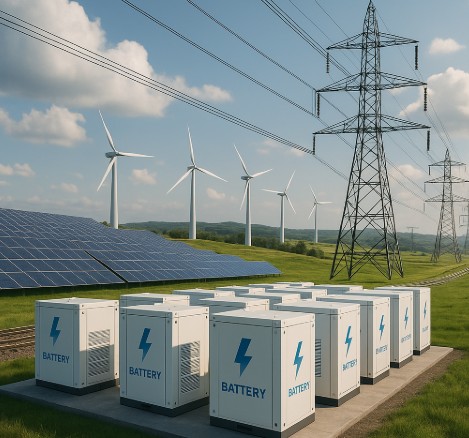Thought Experiment: The Capacitance Grid
We often celebrate solar panels and wind turbines as the heroes of clean energy. And they are—but they come with a hidden challenge. The sun doesn’t always shine, and the wind doesn’t always blow where or when we need the power. That’s not a failure of the energy sources themselves—it’s a limitation of the infrastructure we use to move and store energy.
So here’s the idea:
What if we stopped trying to force clean energy to work like fossil fuels—and started adapting our grid to work like nature?
Imagine a national—or even global—electric grid designed not just for transmission, but for capacitance. That is, energy storage and stability built right into the system. Picture battery stations placed at critical points:
- Near factories and cities to stabilize high-energy draw.
- Along rural transmission lines to prevent drop-off.
- Beside solar farms, wind fields, and wave generators—holding that energy until the grid is ready for it.
These stations would act like power reservoirs, capturing excess energy when production is high and releasing it when demand spikes. They wouldn’t generate energy, but they’d keep the lights on and the system steady. In a grid increasingly shaped by unpredictable but renewable inputs, this kind of built-in balance could be revolutionary.
But here’s the catch: storage is expensive.
Battery technology isn’t cheap. Lithium-ion systems—what you’ll find in your phone, your car, or your home battery wall—are still costly to scale, and they rely on rare, geopolitically tricky materials like lithium and cobalt. That creates bottlenecks—not just in price, but in supply chain vulnerability.
This is where our thought experiment takes a turn toward a very real, very promising alternative: Sodium-ion batteries.
Why sodium?
Sodium is abundant. Dirt-cheap. Easy to source. And sodium-ion batteries, which function much like their lithium cousins, are quickly catching up in terms of durability and performance. They don’t offer the same energy density—which means they’re bulkier and heavier for the same amount of power—but that’s only a problem when size and weight matter.
So they’re not ideal for cars, planes, or your pocket. But you know where size doesn’t matter?
A battery station sitting on a concrete slab in the middle of a grid system.
There, sodium-ion’s drawbacks become irrelevant. Instead, the upsides shine:
- Low cost.
- Abundant materials.
- Safer chemistry (less prone to fire or thermal runaway).
- Long cycle life for stationary charge-discharge cycling.
You could build sodium-ion “capacitance hubs” across the grid like a web of energy warehouses—cheap, effective, and sustainable.
And here’s the fun part: this isn’t sci-fi.
The tech exists. The materials exist. The need is very real. What’s missing isn’t innovation—it’s vision. It’s the commitment to build a grid that’s not just long enough, but deep enough to hold power until it’s needed.
This is just a thought experiment, but it’s meant to spark something important.
Ideas are free. They don’t require permits or funding or corporate backing to exist. But sometimes, a good idea spoken out loud is enough to get the wheels turning—at your city council, at your utility provider, or even just in your own mind.
Because building a better world doesn’t always start with blueprints. Sometimes it starts with the question:
What if we could?


